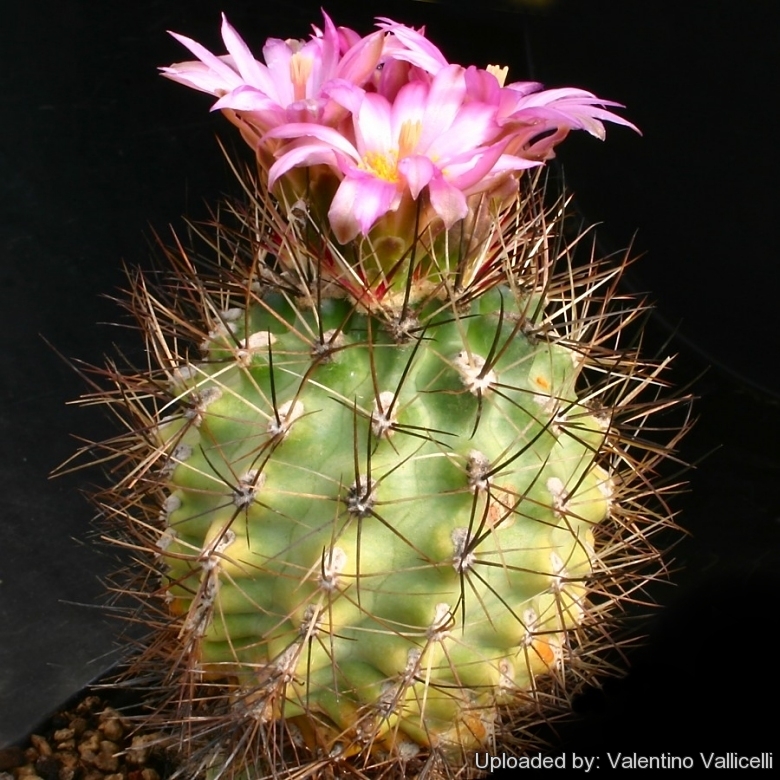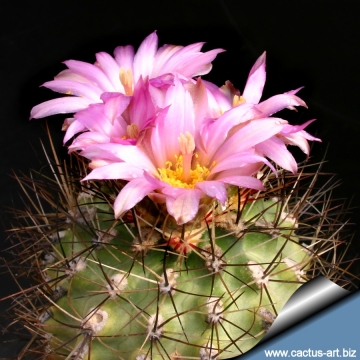Accepted Scientific Name: Sclerocactus glaucus (K.Schum.) L.D.Benson
Cact. Succ. J. (Los Angeles) 38: 53. 1966

Sclerocactus franklinii Photo by: Valentino Vallicelli
Origin and Habitat: Mesa County and Delta County, Colorado (Northwestern U.S.A., Northern America)
Type locality: South rim of Gunnison Valley, one or two miles east of Delta, Delta County, Colorado.
Altitude: Around 1400 metres above sea level.
Synonyms:
See all synonyms of Sclerocactus glaucus
Description: Sclerocactus frankliniiSN|13861]]SN|19476]] is a morphological or local form of the variable Sclerocactus glaucusSN|19476]]SN|13861]]. It was described by Evans (1939) from close by the type locality of Sclerocactus glaucusSN|13861]]SN|13861]]. More recent observations of the extent of variation in Sclerocactus glaucusSN|13861]]SN|13861]] populations has led many authors to conclude that Sclerocactus frankliniiSN|13861]]SN|19476]] was a synonym of the bluegreen Sclerocactus glaucusSN|19476]]SN|13861]] because it is not sufficiently distinct to deserve its own formal status.
Subspecies, varieties, forms and cultivars of plants belonging to the Sclerocactus glaucus group
 Sclerocactus franklinii J. W. Evans: is s local form of Sclerocactus glaucus, but not sufficiently distinct to deserve its own formal status. Distribution: Mesa and Delta County, Colorado.
Sclerocactus franklinii J. W. Evans: is s local form of Sclerocactus glaucus, but not sufficiently distinct to deserve its own formal status. Distribution: Mesa and Delta County, Colorado.- Sclerocactus glaucus (K.Schum.) L.D.Benson: Ball-shaped cactus, single or clumping. Stems green or powdery blue coloured 4 to 30 cm tall, 4 to 9 cm in diameter. Central spines unhooked, the lower ones brown, the upper ones white 1-3 cm long, 6 to 8 radials, 5 mm long. Flowersl purplish-red or pink.
 Sclerocactus glaucus '' Debeque form '' (K.Schum.) L.D.Benson: It has tall larger blue body with stiff spines. It grows in northern edge of distribution for this species.
Sclerocactus glaucus '' Debeque form '' (K.Schum.) L.D.Benson: It has tall larger blue body with stiff spines. It grows in northern edge of distribution for this species. Sclerocactus glaucus f. cristata hort.: Crested form easily recognizable for the characteristic unhooked central spines.
Sclerocactus glaucus f. cristata hort.: Crested form easily recognizable for the characteristic unhooked central spines.- Sclerocactus glaucus subs. wetlandicus var. ilseae (Hochstätter) Hochstätter
 Sclerocactus wetlandicus Hochstätter: Morphologically very similar to Sclerocactus glaucus, but the two populations are geographically separated.
Sclerocactus wetlandicus Hochstätter: Morphologically very similar to Sclerocactus glaucus, but the two populations are geographically separated. Sclerocactus wetlandicus f. cristata hort.: Crested form easily with unhooked central spines. Several clones do exist.
Sclerocactus wetlandicus f. cristata hort.: Crested form easily with unhooked central spines. Several clones do exist.
Bibliography: Major references and further lectures
1) Edward Anderson “The Cactus family” Timber Press, Incorporated, 2001
2) James Cullen, Sabina G. Knees, H. Suzanne Cubey "The European Garden Flora Flowering Plants: A Manual for the Identification of Plants Cultivated in Europe, Both Out-of-Doors and Under Glass" Cambridge University Press, 11/Aug/2011
3) David R Hunt; Nigel P Taylor; Graham Charles; International Cactaceae Systematics Group. "The New Cactus Lexicon" dh books, 2006
4) Urs Eggli, Leonard E. Newton: “Etymological Dictionary of Succulent Plant Names.” Birkhäuser 2004
5) Lyman David Benson “The Cacti of the United States and Canada” Stanford University Press, 1982
6) Butterworth, C. & Porter, J.M. 2013. Sclerocactus glaucus. In: IUCN 2013. "IUCN Red List of Threatened Species." Version 2013.2. <www.iucnredlist.org>. Downloaded on 04 December 2013.
 Sclerocactus franklinii Photo by: Cactus Art
Sclerocactus franklinii Photo by: Cactus ArtSend a photo of this plant.The gallery now contains thousands of pictures, however it is possible to do even more. We are, of course, seeking photos of species not yet shown in the gallery but not only that, we are also looking for better pictures than those already present.
Read More... Cultivation and Propagation: This plant is very rare in cultivation, it is difficult to grow on its own roots and to propagate. Mature individuals easily rot and die especially after planting. The seeds germinate with extreme difficulty and a low rate of success, seedlings do not do well either, and more die each year. Sclerocactus frankliniiSN|19476]]SN|19476]] is extremely xerophytic and adapted to very dry soils, but plants grafted on hardy stock (Opuntia humifusaSN|11629]]SN|11629]], Echinocereus triglochidiatusSN|10576]]SN|10576]] etc...) are relatively easy to grow and no special skill is required, they can stay in a non heated green house. (min tem -20°C) ... This interesting cactus, continues to be a particular prize among specialist collectors.
Propagation: Seeds are extremely difficult to germinate (only 2-3 percent of seeds germinate). The germination is really difficult and if some seedling finally sprout, as they start to grows they disappear one by one. Grafting is often used to speed growth rate and to create a back-up for plants in collection.











